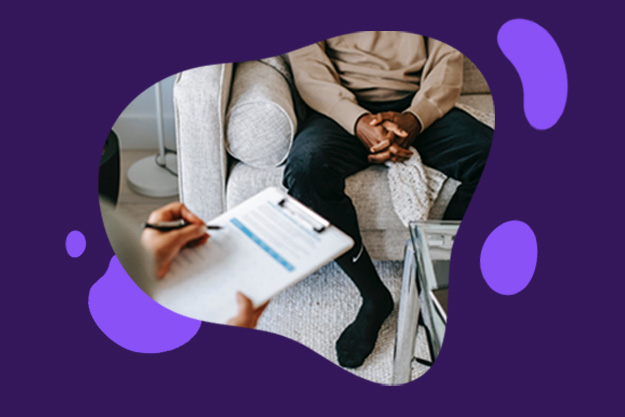4 min read
Behavioral Health, Teletherapy, and EAP: What’s the Difference?
 Claire Wiseman Imber
:
May 6, 2021
Claire Wiseman Imber
:
May 6, 2021

Mental health was at the top of many employers’ minds before the pandemic, and we’re only beginning to see how more than two years of lockdowns, closures, and isolation will impact employees.
An article published in the Journal of the American Medical Association (JAMA) revealed that COVID-19 has tripled the rate of depression in U.S. adults, disproportionately affecting those with lower income.
Taken together, mental health concerns are a threat to employees that employers can’t ignore. Mental health benefits, including, Behavioral Health, Teletherapy, and Employee Assistance Programs (EAP), can be difficult for employees and HR to differentiate. In this post, we’ll explain the difference between these mental health resources for employees.
What are Behavioral Health Programs?
Behavioral health programs offer employees therapeutic resources to help them develop healthy behaviors. That usually includes therapy, and in some cases can include support for healthy eating, movement, and meditation. Behavioral health practitioners treat conditions that impact overall wellness, including physical and mental health. Workplace behavioral health programs help employees deal with substance abuse, addiction, gambling, and other problems that affect work performance. Behavioral health services can also help those struggling with mental health disorders, like anxiety and depression, by addressing the behaviors that make their symptoms worse and developing habits that help them feel better.
Virtual behavioral health programs make it easier for employees to access teletherapy, a key component of many modern workplace behavioral health programs.
What is teletherapy?
Teletherapy is the focus of HealthJoy Behavioral Health. Broadly, teletherapy is an online, video-based version of talk therapy. In talk therapy, therapists may rely on a variety of tools, including cognitive behavioral therapy (CBT). In CBT, therapists use different strategies to change thinking patterns. The focus of CBT is on building healthy habits and changing behaviors; this is one reason it’s a good fit with many behavioral health plans. Virtual talk therapy like all talk therapy focuses on building a relationship with a therapist over the long term and can help with depression, anxiety, trauma, and other mental health concerns. In contrast, the short-term counseling offered in an Employee Assistance Program, or EAP, (which we’ll discuss below) may help an employee cope with a recent loss, a marital problem, or other acute stress.
Like telemedicine, teletherapy isn’t new, but it is growing in popularity and acceptance in the medical community. Studies show varying teletherapy models can effectively treat depression, substance use, and post-traumatic stress disorder (PTSD), among other conditions.
Teletherapy lowers barriers to care and is often less expensive than traditional therapy. It can also be just as effective as in-person therapy. In fact, its popularity has surged during the COVID-19 pandemic, when mental health providers were not seeing patients in person due to health risks and stress levels were at an all-time high.
And it shows no signs of slowing down. Sixty-two percent of consumers would prefer a virtual visit for their regular mental health visits, even after it is safe to visit a doctor’s office in person.
To recap, Behavioral Health Programs:
- Help employees develop healthy behaviors to address mental health concerns
- In the workplace, often focuses on mental health resources, including therapy
- Can include mental health, but aren’t limited to it
And teletherapy:
- Is talk therapy offered over video or phone
- Is often offered as part of a workplace behavioral health program
- Allows employees to develop a long-term relationship with a single therapist
- Is a proven treatment for mental health conditions
- Usually costs employees a flat fee, but can be subsidized by employers
What are Employee Assistance Programs (EAPs)?
Employee Assistance Programs evolved to address the problems most likely to impact employee performance. If it distresses and distracts employees, there’s probably an EAP resource to address it. The other main difference between EAP and behavioral health programs is the scope of what they cover.
Behavioral health programs tend to focus on the individual and address mental, emotional, and physical sources of stress to create healthier behaviors. A typical EAP offering usually focuses on outside stressors, like financial problems, elder care, or legal concerns. Usually, EAP counseling sessions are available for a limited number of visits at no cost to employees.
An employee assistance program typically includes some combination of the following mental health resources:
- Short-term counseling – typically, anywhere from 3-10 sessions with a counselor to help employees address acute issues. The counselor may also use this time to direct employees to additional resources, like substance abuse support groups
- Financial counseling – resources to help employees manage their budgets, address debt, and more
- Legal services – free legal counsel for divorce, bankruptcy, and more
- Adoption assistance – free legal and financial support for employees who want to pursue adoption
- Child and elder care services – resources and support for caregivers
- Substance abuse referral services – short-term counseling and group support resources specifically for employees struggling with substance abuse
- Workplace trauma counseling – support for employees struggling with trauma after incidents of workplace violence
To recap, EAP:
- Connects employees with resources that help them deal with stress
- Includes short-term counseling, as well as other services like legal and financial support
- Can help employees connect with long-term counseling resources like teletherapy
- Is usually free for employees
How it works with HealthJoy:
Just like HealthJoy Behavioral Health, members access HealthJoy EAP from the app. With a few taps, they can connect immediately with an EAP counselor by phone. From there, the counselor will direct members to the services they need. That might include short-term counseling or a combination of some of the other resources listed above. Members don’t need to wait to set up an appointment, and counselors are available 24/7. Like teletherapy, EAP counseling sessions are completely confidential. We can work with an employer’s existing EAP provider or clients can elect to provide HealthJoy EAP.
Explaining Your Mental Health Resources to Employees
If you need to brush up on the difference between these mental health resources for employees, chances are they do, too. Now more than ever, employees need all the help they can get. Take this opportunity to remind them how their benefits can help, and don’t forget to explain the difference between any overlapping benefits like behavioral health and EAP. Enumerating small differences like price, duration of counseling, and how to access each resource can go a long way toward breaking down barriers to mental health support, improving overall employee wellness, and boosting employee morale.
This post was originally published in June 2020. It was updated in May 2021.

From Empathy to EAP: Mental Health Support for Returning Employees
These constantly-changing plans put employees in a precarious position: adding mounting fear, anxiety, stress, and worse to their existing workload.

3 min read
Why Your Company Needs to Address Mental Health
For the average adult in the US, spending a third of their lives in the workplace is just a fact. So it’s no wonder the state of employees’...








